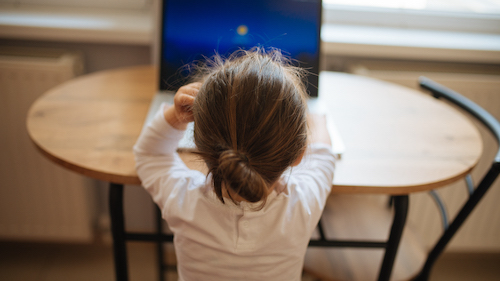
Whatever the challenges universities face in switching to remote learning, they are way more intense for K-12 schools. Equity issues around technology are certainly a big reason why, but Professor of Educational Technology Stein Brunvand actually thinks technology-related challenges may not be the most fundamental ones K-12 schools will face if remote learning is still their M.O. this fall. We recently chatted with Brunvand to lay out what it will take to make a remote K-12 school year really work.
So we definitely want to get your thoughts about what the upcoming school year might look like, but before we get to that, let’s talk briefly about the current one. Students are still technically in school now, right?
Yeah, K-12 districts are obviously in a really tricky situation. For institutions like universities, we certainly have a moral obligation to ensure our students have access to the technology they need to learn online. But we also have expectations when we’re working with adult learners that most of them are going to secure that themselves. K-12 districts are dealing with a much different situation. They are legally obligated by the state to make sure all of their students have equal access to educational opportunities. That means they can’t move forward with districtwide plans for remote instruction without first ensuring that everyone can reasonably access that instruction in some way.
Districts are dealing with that in different ways. Some are reaching out to their families to see who still needs, say, a laptop — and often, I should note, that means one laptop per family, not per student. And I know some companies are helping out to provide families with internet access who didn’t have it previously. Schools are also putting together non-digital alternatives, like curriculum packets, that families can come pick up and take home. But it’s important to recognize that this is all still voluntary. Students are encouraged to complete the work, and the work will be graded if it’s completed. But if you don’t do the work, it won’t count against you, and most districts are giving students the option to take whatever their grade was before face-to-face teaching stopped. That obviously presents a sticky situation, because suddenly there's not a whole lot of incentive for students. I think many people have been understanding of this voluntary approach thus far, because it was an emergency situation. The reality was schools simply couldn’t provide an equal opportunity to everyone, so they essentially called a time out.
But it sounds like you don’t expect that dynamic will last into the fall.
Well, I think the main difference is that we’ll have had four months to prepare, which still isn’t a lot of time, but districts will be expected to get the access situation sorted out. And if schools are teaching largely online in the fall, the expectations are going to be that they provide a high-quality online experience for students. I’m generally an optimistic person, but I think we need to understand what a big challenge that will be for many districts. When we think about this topic, we talk a lot about technology, but in some ways, many of those challenges have more straightforward solutions. To me, the broader issue is that online learning requires much more independence among students, and typically requires substantial parental involvement — especially as you move down in grade level. How do we, for example, meet the needs of learners that have different learning styles or need more one-on-one or small group interaction? In most households, providing that support is going to fall to a parent or an older sibling, who almost becomes the classroom paraprofessional. And if that parent is already having to work through this pandemic — either at home or outside the home — how do they do that and maintain their employment? Prior to all this, families scrambled enough when there was a snow day. This is the never ending snow day. And the solution to that is not a technological one.
Well, you said you were an optimistic person. Are there approaches that could at least ameliorate some of these issues?
For starters, a Department of Education like ours, which has a teacher certification program, could be put to use. As part of their coursework, our teachers in training have to be out in the field for practicum classes. But could they be deployed as virtual tutors or paraprofessionals in districts that can’t afford to suddenly hire a bunch of new support staff for remote learning? I also recently read through West Bloomfield’s plan for the fall, and they’re planning to do face-to-face instruction two days a week and the rest would be online. One of the things that’s interesting about that modified approach is that it might allow districts to be mindful about which students would benefit the most from face-to-face instruction. Right now, for example, there is typically an application process for high school students who want to take online courses, and that’s designed to ensure that they have what they need to thrive in an online environment. You could see something similar evolving, where schools may be open five days a week, but not every student is coming in every day. Students with the greatest needs could be prioritized for face-to-face instruction, while students who are better equipped to learn online could come to school less often.
Another possibility that’s sort of similar to this is the “flipped” classroom, which we use a lot at the college level. That’s where the core instruction is in a virtual format, and face-to-face time is used for assignments or what we’d typically think of as homework. I could see that becoming useful if teachers had only limited face-to-face time with their students. But again, as with many of these solutions, that’s harder to deploy the further you move down in grade level, because younger learners can’t be expected to work as independently.
You mentioned the role your department could play in helping schools out. Are there any other fronts you’re working on?
Well, first and foremost we’re really trying to make sure the students in our program are prepared for whatever they might experience in the fall if they’re placed virtually in schools for practicums, or possibly even as virtual student teachers if that’s allowed by the state. It’s something that has a lot of promise, though, because we could create partnerships with districts that aren’t immediately in our area and it would give students more flexibility in how they get those practicum hours. We’re also looking at offering a one-credit class on creating online learning experiences that we’d also like to make available as a workshop for teachers. That should be running after July 4.
In many settings, the pandemic seems to be pushing us to do creative things that we weren’t quite brave enough to try before. But now that they’re a necessity, we’re figuring out we can do them. Are you seeing that in the education field?
I think if you’re looking for a silver lining in this pandemic, I guess that’s it. I’ve definitely had the thought that ‘Wow, it only took a worldwide virus to get our colleagues to try out some of these new approaches,’ and if some of that stuff sticks, that could be a great thing for everyone. I mean, if we end up with new ways for our teachers in training to help really challenged districts, and new ways for K-12 schools to reach students online, then it’s true that in some ways, we may emerge from all this with a whole new set of opportunities.





